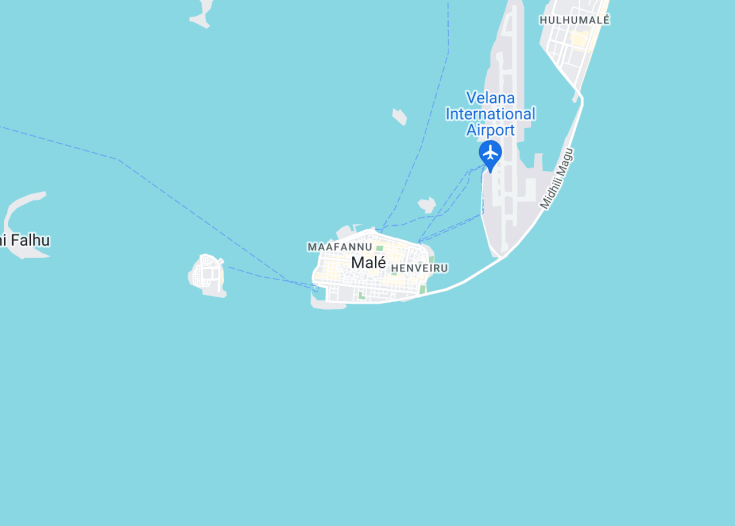Malé, the vibrant capital of the Maldives, stands out as a bustling hub contrary to the tranquil ambiance spread across the rest of this picturesque archipelago. This compact island city is packed with colorful buildings, numerous mosques, and local markets, offering visitors a unique glimpse into the Maldivian way of life. Its strategic location makes it a perfect starting point for exploring the surrounding islands and indulging in various water-based activities, making it an undoubtedly essential stop for culturing the region’s extensive heritage and breathtaking natural beauty.
While in Malé, be sure to visit the local market for authentic Maldivian crafts and fresh produce, providing a genuine taste of island life.
Consider booking a guided city tour to ensure you experience all the historical and cultural highlights Malé has to offer, conveniently and informatively.
How to best experience Malé?
Search for Tickets, tours, and activities in Malé using direct search on the following providers:
GetYourGuide.com Viator.com Trip.com Expedia.com Tiqets.com Ctrip.com (中文)
Malé: The Vibrant Heart of Maldives
| Country | Maldives |
| Time in Malé | GMT+5 |
| Language spoken | Dhivehi |
| Population | 133,412 (World Population Review, 2023) |
| Currency | Maldivian Rufiyaa (MVR, ރ.) |
| Airports | Velana International Airport (2 mi / 3.2 km). |
Malé, the bustling capital of the Maldives, encapsulates the heart and spirit of this tropical paradise. With its picturesque sea views, dense cultural fabric, and vibrant markets, Malé offers a unique glimpse into the Maldivian way of life.
Where is Malé?
Malé is geographically located at the southern edge of North Malé Atoll, in the Maldives archipelago in the Indian Ocean.
Distances:
| Route | Distance by car | Time by car |
|---|---|---|
| From Hulhumalé | 5.3 mi | 15 min |
| From Vilimalé | 2.7 mi | 10 min |
| From Gulhi Island | 12.7 mi | 50 min |
What is Malé famous for?
Malé is renowned for its dense combination of city life and lush sceneries, bustling local markets, and historical landmarks like the Old Friday Mosque, an epitome of traditional Maldivian architecture.
History
Malé, the capital of the Maldives, boasts a rich tapestry of history that extends from its early settlement to its current status as a thriving urban center. This narrative unfolds through various historical periods, each marked by significant developments.
Early Settlement (Before 12th Century)
The Maldives were first settled by fishermen from the coasts of the Indian Subcontinent and sailors who traversed the trade routes of the Indian Ocean. Early inhabitants were likely drawn to Malé’s abundant marine resources, propitious for the establishment of a community. Over time, the island emerged as a central point of trade and commerce.
Islamic Conversion and Sultanate Establishment (1153-1968)
In 1153, Malé marked a transformative chapter in its history with the conversion of its population to Islam by Abu al-Barakat Yusuf al-Barbari, an event that profoundly influenced the island’s cultural and political landscape. This period saw the establishment of the Sultanate of the Maldives, with Malé as its beating heart. The ruling dynasties fortified the island, and Malé blossomed into a hub of Islamic scholarship and architecture.
Colonial Influence and Modernization (16th Century-1965)
The Portuguese briefly captured Malé in 1558, leaving a mark on its urban fabric and fortifications. However, the Maldivians soon ousted the Portuguese, and the island came under the influence of various colonial powers, including the Dutch and the British. The British period, which began in the mid-19th century, led to significant modernization initiatives in Malé, though it remained under the indirect rule of the Sultanate until the Maldives gained independence in 1965.
Republic Era and Contemporary Developments (1968-Present)
With the abolition of the Sultanate and the establishment of a republic in 1968, Malé entered a new era of development. The city modernized rapidly, with the construction of new schools, hospitals, and infrastructure. Today, Malé is a bustling metropolis, characterized by tall buildings, narrow streets, and a densely packed population. It reflects a blend of traditional Maldivian culture with modern advancements, making it a unique cornerstone of the nation’s heritage and contemporary identity.
Visit Malé
What to see and do in Malé
Exploring Malé offers a unique blend of cultural and modern attractions. Key sights include:
- The Malé Friday Mosque, an exquisite example of ancient Islamic architecture richly adorned with carvings and Arabic script.
- The National Museum, located in Sultan Park, which houses artifacts that trace the rich history of the country.
- The bustling local markets such as the Fish Market and the Local Market, where visitors can immerse themselves in the daily life of the Maldivians.
- Hukuru Miskiy, another ancient mosque that dates back to the 17th century, known for its intricate wood carvings and religious significance.
- The Artificial Beach, offering leisure activities and occasional cultural performances.
Festive Highpoints in Malé
Malé’s calendar is punctuated with vibrant festivals and events. Noteworthy among these is the Maldives Independence Day celebrated on July 26th, featuring parades and various public performances. Another significant event is the Maldives National Day, which commemorates the defeat of Portuguese invaders and is marked by numerous cultural events and displays of traditional Maldivian crafts.
Best time to visit Malé
The ideal time to visit Malé is between November and April, when the weather is dry and the seas are calm, providing perfect conditions for sightseeing and participation in outdoor activities.
Is Malé worth visiting?
Malé offers a unique glimpse into the Maldivian way of life and its rich historical tapestry, juxtaposed with modern developments. While the city is densely populated and can seem crowded, its cultural sites, vibrant markets, and the warmth of the Maldivian people make it a worthy destination. However, travelers looking for tranquil beach vacations might find the bustling city atmosphere challenging. Overall, for those interested in culture and history, Malé is definitely worth a visit.

